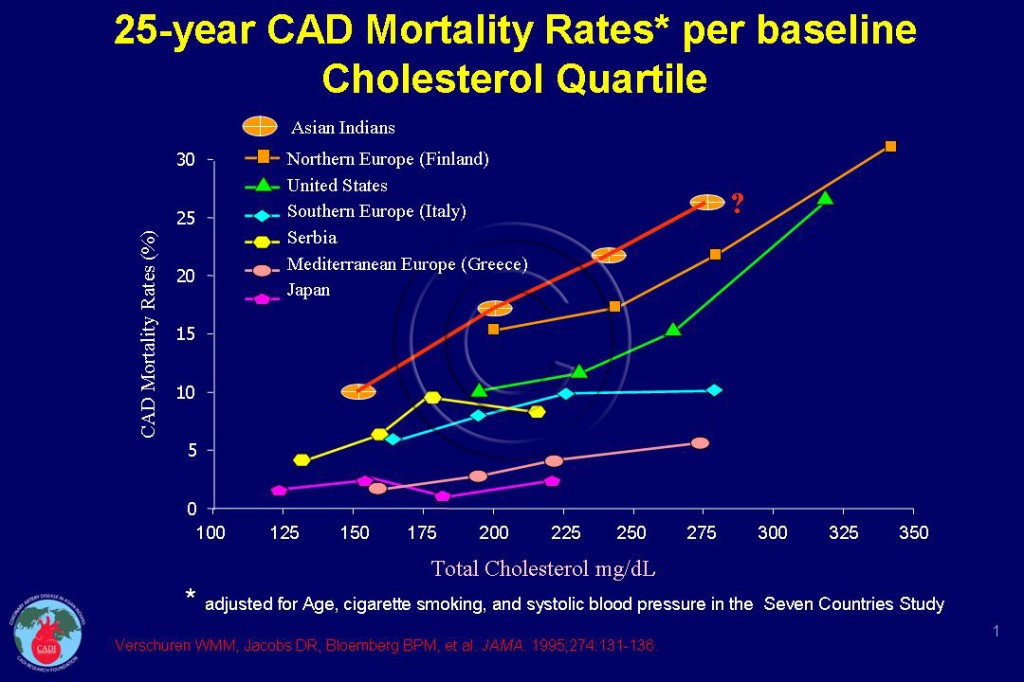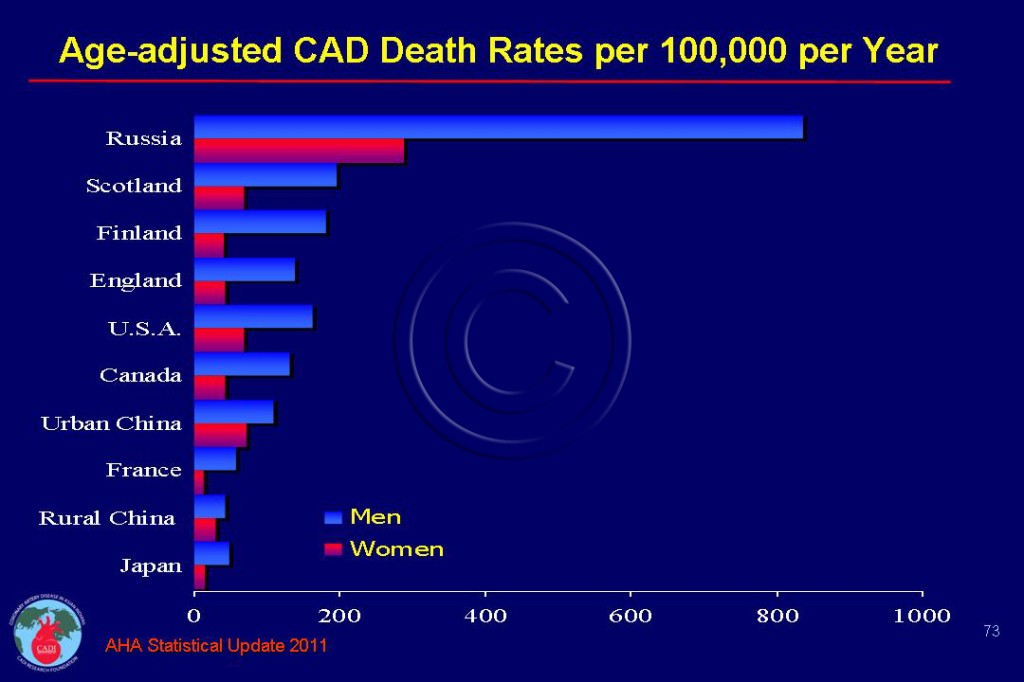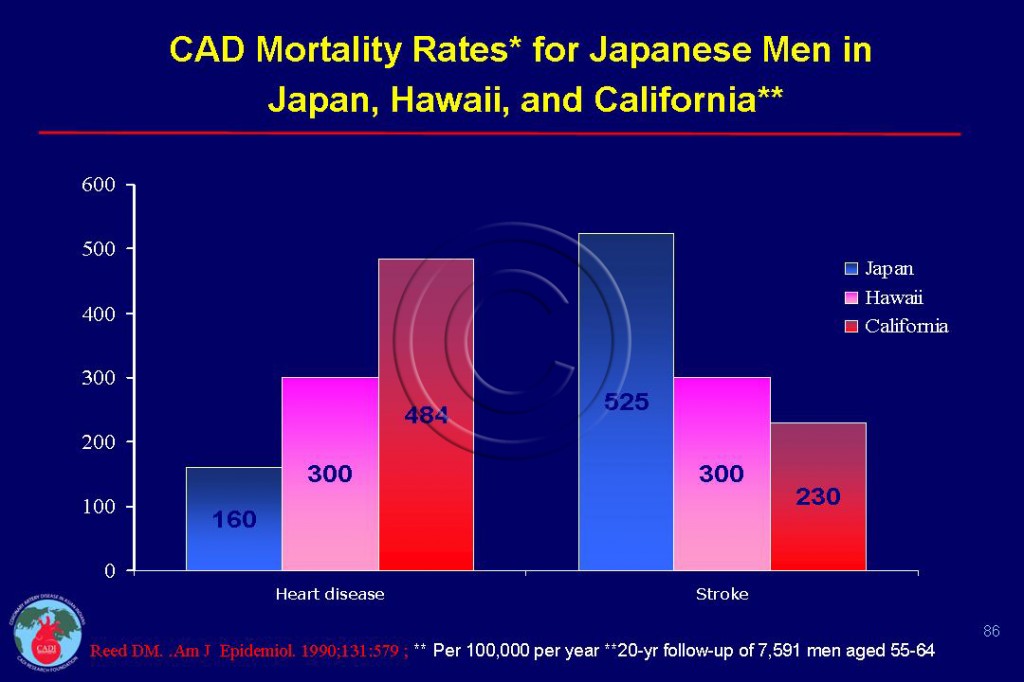Japanese Heart Disease
- The Japanese cohort of the Seven Countries Study had the lowest age-standardized 25-year CAD (coronary artery disease) mortality among all 16 cohorts, although 74% of the Japanese were smokers.1 CAD rates in Japan were about 5-fold lower than the U.S. (Figure 001).
- Despite its affluence (third largest economy) and rapid urbanization, Japan has reduced its already low CAD rate by 60% and continues to have the lowest rates of CAD upon international comparison2 (Figure 073 Asians).
- Japan is unique among high-income countries that did not experience an increase in CAD rates and remained lowest among the industrialized countries despite its rapid economic development and longest lifespan (78 years for men and 83 years for women). In fact Japan is the only developed country to avoid an increase in heart disease rates commensurate with economic development.
- Between 1968 and 2002, the age-standardized death rates (per 100,000 for people 35-74 years of age ) for heart disease decreased 42% (from 92 to 53) in men and 62% (from 45 to 17) in women.3
- The factors contributing to the low rates of CAD among Japanese include high HDL levels (55 mg/dL in men and 65 mg/dL in women vs 39 mg/dL and 43 mg/dL in Asian Indian men and women respectively), low total cholesterol (TC), very low TC/HDL ratio and high consumption of fish and soy proteins.4 Although cholesterol levels increased from 152 mg/dl to 194 mg/dl, CAD rates remained low, but may increase after the long incubation period is over.
- The age-adjusted stroke mortalityrate in Japan was the highest in the world from 1950 to the1970s, but has dramatically decreased by 75%. For every death from heart disease 5 stroke deaths were reported in Japan in the 1960s which has decreased to 2 stroke deaths by 2000.5, 6 The pattern of stroke in Japan has become similar to that in western countries in recent decades.
- Overall CVD rates have fallen 60% since 1960s, largely because of the dramatic decrease in stroke. Better management of blood pressure is believed to be main factorsin decreasing the incidence and mortality from stroke.
- Most recently, (2011) incidences of heart attack and stroke per 1000 person-years were 4 and 7 respectively.7
- Both diabetes and prediabetes are associated with incident CAD in the general Japanese population. The population attributable risk of coronary events from diabetes was estimated to be moderate, accounting for 13% of all CAD events.8
- In the last half of the century, there was a 9-fold increase in the estimated annual per capita consumption of meat, 7-fold increase in milk and dairy products, and 5-fold increase in the consumption of fats and oils in Japan. The fat intake increased from 5% to 20% and protein intake increased from 11% to 18% and carbohydrate intake decreased from 84% to 62% of the daily energy.9
Japanese Americans
- The landmark NI-HON-SAN Study has evaluated the impact of immigration of Japanese from Japan to US. In 10 years of follow-up of 7705 Japanese men living in Hawaii, the incidence rate of CAD (both fatal and nonfatal) was less than half the rate for US whites and approximately twice the rate for Japanese men in Japan. This is in sharp contrast to Asian Indians who have a 4-fold higher prevalence and incidence of CAD than whites.
- Despite higher levels of cholesterol, Japanese in Hawaii had half the rates of CAD than whites possibly due to lower levels of cholesterol at younger ages and higher levels of HDL cholesterol.10
- More importantly, the overall CVD mortality rates among Japanese Americans were 40% lower than native Japanese, due to a greater decrease in stroke mortality than increase in CAD mortality.11 The changes in CAD and stroke mortality rates among Japanese Americans in Hawaii and San Francisco compared to those who did not immigrate is given in Figure 086.12
- There was a dramatic increase in the intake of saturated fat resulting in an increase in blood cholesterol levels. There was also significant increase in weight and consumption of refined carbohydrates that resulted in dramatic increase in diabetes as shown in the table below.
| Mean values of selected factors at the baseline in NI-HON-SAN Study13, 14 | |||
| Japan N=1717 | Hawaii (n=7649) | California ( n=1780) | |
| Body weight (kg) | 55 | 63 | 68 |
| Total calories | 2131 | 2274 | 2268 |
| Dietary cholesterol (mg) | 457 | 545 | 536 |
| Saturated fat (g) | 16 | 59 | 66 |
| Unsaturated fat (g) | 21 | 26 | 29 |
| Simple carbohydrates (g) | 61 | 92 | 96 |
| Complex carbohydrates | 278 | 169 | 155 |
| Alcohol (g) | 28 | 13 | 9 |
| Animal protein (g) | 40 | 71 | 66 |
| Vegetable protein (g) | 37 | 24 | 23 |
| % calories from protein | 14 | 17 | 16 |
| % calories from fat | 15 | 33 | 38 |
| % calories from saturated fat | 6 | 13 | 15 |
| % calories from carbohydrates | 63 | 46 | 44 |
| Systolic blood pressure (mmHg) | 133 | 133 | 138 |
| Cholesterol (mg/dl) | 181 | 218 | 226 |
| Cholesterol >260 mg/dl | 3 | 12 | 16 |
| Triglyceride (mg/dl) | 134 | 229 | 235 |
| Diabetes (Glucose >200 in mg/dl after 50 g of oral glucose) % | 6 | 25 | 25 |
- The age-adjusted CAD mortality rate was 40% higher in Hawaii than in Japan at the 12 yr follow-up of NI-Hon-SAN Study. More than half of this difference in mortality rate was attributed to different levels of known risk factors in the two cohorts. Age, blood pressure, serum cholesterol, serum glucose, cigarette smoking, and alcohol intake (inversely) remained as significant predictors of CAD mortality.15
- Among the characteristics studied, systolic blood pressure was the most powerful and consistent risk factor. Cigarette smoking showed a similar pattern. Serum cholesterol was significantly associated CAD but its contribution to CAD risk was less potent than systolic blood pressure or cigarette smoking.16 This is in sharp contrast to whites and Asian Indians among who blood cholesterol level is the foremost risk factor for heart disease.
- A study of 1,000 sons and daughters of the HHP cohort it was found that BMI and prevalence of diabetes were much higher in sons and daughters than in their fathers, whereas total cholesterol was lower in sons and daughters.17
Sources
1. Verschuren WMM, Jacobs D, Bloemberg B, et al. Serum total cholesterol and long-term coronary heart disease mortality in different cultures: Twenty-five year follow-up of the Seven Countries Study. JAMA. 1995;274:131-136.
2. Tunstall-Pedoe H, Kuulasmaa K, Amouyel P, Arveiler D, Rajakangas AM, Pajak A. Myocardial infarction and coronary deaths in the World Health Organization MONICA Project. Registration procedures, event rates, and case-fatality rates in 38 populations from 21 countries in four continents. Circulation. 1994;90(1):583-612.
3. www.heartstats.org. CHD Statistics. mortality. 2008. Accessed May 1,2010.
4. Ueshima H, Iida M, Shimamoto T, et al. High-density lipoprotein-cholesterol levels in Japan. JAMA. 1982;247:1985-1987.
5. Khaw KT. Epidemiology of coronary heart disease in women. Heart. May 2006;92 Suppl 3:iii2-4.
6. Levi F, Lucchini F, Negri E, La Vecchia C. Trends in mortality from cardiovascular and cerebrovascular diseases in Europe and other areas of the world. Heart. 2002;88(2):119-124.
7. Sone H, Tanaka S, Iimuro S, et al. Serum Level of Triglycerides Is a Potent Risk Factor Comparable to LDL Cholesterol for Coronary Heart Disease in Japanese Patients with Type 2 Diabetes: Subanalysis of the Japan Diabetes Complications Study (JDCS). J Clin Endocrinol Metab. Aug 24 2011.
8. Saito I, Kokubo Y, Yamagishi K, Iso H, Inoue M, Tsugane S. Diabetes and the risk of coronary heart disease in the general Japanese population: the Japan Public Health Center-based prospective (JPHC) study. Atherosclerosis. May 2011;216(1):187-191.
9. Adachi H, Hino A. Trends in nutritional intake and serum cholesterol levels over 40 years in Tanushimaru, Japanese men. J Epidemiol. May 2005;15(3):85-89.
10. Gordon T, Garcia-Palmieri MR, Kagan A, Kannel WB, Schiffman J. Differences in coronary heart disease in Framingham, Honolulu and Puerto Rico. J Chronic Dis. Sep 1974;27(7-8):329-344.
11. Benfante R. Studies of cardiovascular disease and cause-specific mortality trends in Japanese-American men living in Hawaii and risk factor comparisons with other Japanese populations in the Pacific region: a review. Hum Biol. 1992;64(6):791-805.
12. Reed DM. The paradox of high risk of stroke in populations with low risk of coronary heart disease. Am J Epidemiol. 1990;131(4):579-588.
13. Robertson TL, Kato H, Gordon T, et al. Epidemiologic studies of coronary heart disease and stroke in Japanese men living in Japan, Hawaii and California. Coronary heart disease risk factors in Japan and Hawaii. Am J Cardiol. Feb 1977;39(2):244-249.
14. Kato H, Tillotson J, Nichaman MZ, Rhoads GG, Hamilton HB. Epidemiologic studies of coronary heart disease and stroke in Japanese men living in Japan, Hawaii and California. Am J Epidemiol. Jun 1973;97(6):372-385.
15. Yano K, MacLean CJ, Reed DM, et al. A comparison of the 12-year mortality and predictive factors of coronary heart disease among Japanese men in Japan and Hawaii. Am J Epidemiol. Mar 1988;127(3):476-487.
16. Yano K, Reed DM, McGee DL. Ten-year incidence of coronary heart disease in the Honolulu Heart Program. Relationship to biologic and lifestyle characteristics. Am J Epidemiol. May 1984;119(5):653-666.
17.Narayan K M, Aviles-Santa L, Oza-Frank R, et al. Report of a National Heart, Lung, And Blood Institute Workshop: heterogeneity in cardiometabolic risk in Asian Americans In the U.S. Opportunities for research. J Am Coll Cardiol. Mar 9 2010;55(10):966-973.




